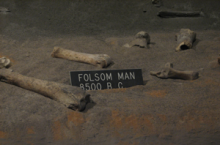Article
Folsom culture refers to a prehistoric group of nomadic hunters that may have hunted bison during the Pleistocene era. The majority of Folsom artifacts date to a period roughly between 9000 BCE and 8000 BCE. Archeological research shows that these hunter-gatherers lived across wide parts of North America, in the regions that stretch from what is now the Southwestern U.S. up through the Great Plains and all the way into Canada. The name Folsom originates in the first archeological site that uncovered this particular period, which was found near the village of Folsom, New Mexico. Traces of a specific "stone age" culture, based on its intricate and detailed stone weapons and tools were unearthed on that site in the early twentieth century, and additional Folsom sites have subsequently been excavated throughout New Mexico, Colorado, and Texas, as well as further up into the northeastern parts of the continent.
The Folsom culture is distinguished from the previous Clovis tradition by the shift from hunting mammoth that were becoming extinct to following herds of bison. This shift required developing new hunting techniques and devising new weapons, namely the famous Folsom point, which is a particular type of arrowhead that is carefully chipped out of flint rock. The typical Folsom arrowhead is characterized by a groove that runs along its center, suggesting that these points were mounted on wooden shafts and darts. The chipping of such grooves—a technique known as fluting—required advanced stone working tools, methods, and skills.
Much of the knowledge about Folsom culture that Tony Hillerman brings to his Navajo detective fiction, including his 1970 novel THE BLESSING WAY and his 1978 novel DANCE HALL OF THE DEAD, derives from the research he conducted for a chapter of his 1968 Masters thesis in English at the University of New Mexico. The chapter, which was published separately in TRUE, a men's journal, and in the 1973 published version of his thesis, THE GREAT TAOS BANK ROBBERY, was entitled, "The Hunt for the Lost American."
"Folsom Ma, circa 8500CE, Blackwater Draw, Clovis, New Mexico, September 3, 2008" by Matt Celeskey is licensed under CC BY-SA.
Manuscripts
A04 Dance Hall of the Dead (04-06) p. 27
A04 Dance Hall of the Dead (04-06) p. 30
A04 Dance Hall of the Dead (04-06) p. 31
A04 Dance Hall of the Dead (04-06) p. 32
A04 Dance Hall of the Dead (04-06) p. 33
A04 Dance Hall of the Dead (04-06) p. 34
A04 Dance Hall of the Dead (04-06) p. 35
A04 Dance Hall of the Dead (04-06) p. 36
A04 Dance Hall of the Dead (04-06) p. 73
A04 Dance Hall of the Dead (04-06) p. 76
A04 Dance Hall of the Dead (04-06) p. 122
A04 Dance Hall of the Dead (04-06) p. 123
References
Hillerman, Tony
1973 "The Hunt for the Lost American." In The Great Taos Bank Robbery and Other
Indian Country Affairs. Pp. 52-75. Albuquerque: University of New Mexico Press.
Melzer, David J.
N.d. Folsom Site, NM. QUEST Archeological Research Program. Southern Methodist
University.
http://www.smu.edu/Dedman/Academics/Departments/Anthropology/Research/Q…,
accessed February 11, 2016.
University of Manitoba
N.d. Folsom Traditions. Manitoba Archeological Society.
https://www.umanitoba.ca/faculties/arts/anthropology/manarchnet/chronol…,
accessed February 11, 2016.

